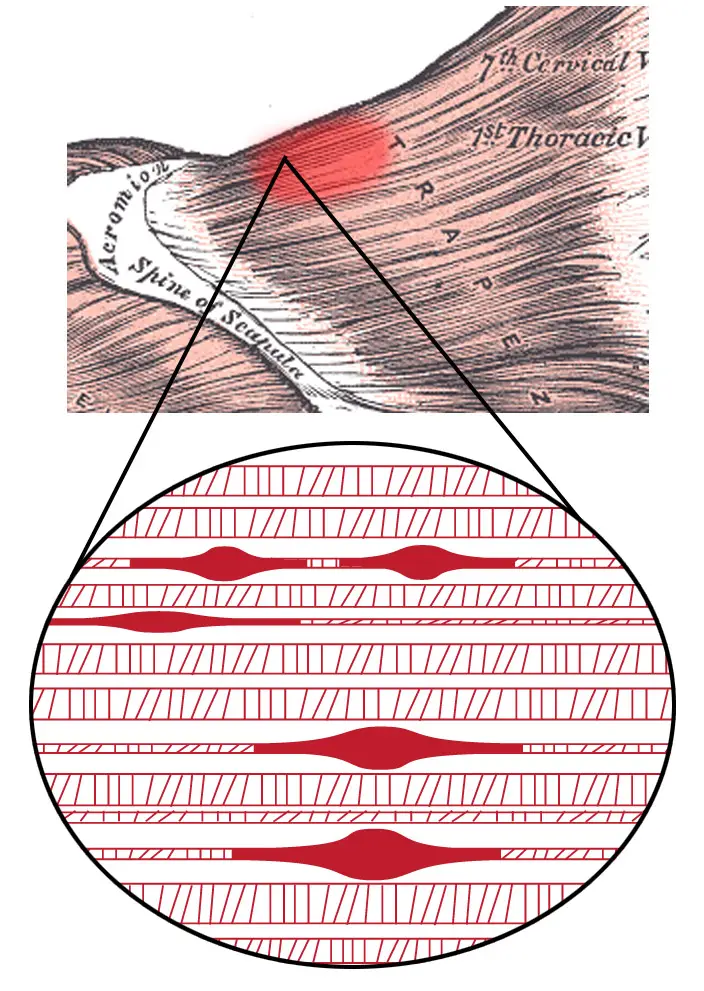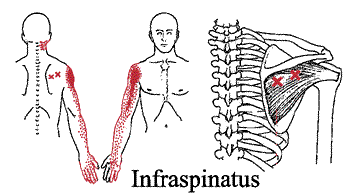What are muscle knots or myofascial trigger points?
“My neck feels so tight and knotted up”, “can you give my shoulder a rub, there are so many knots in them”, etc.
We have heard people referring to these terms time to time in our daily life, but we have hardly ever put real interest in finding out what the real meaning behind it. So, what are muscle knots? What causes them? But most importantly, what can we do to treat and get rid of them?
What are muscle knots?
Muscle knots are jargon term for a more scientific term of trigger points. A trigger point is a hyperirritable spot and a hard, palpable nodule in a taut band of the skeletal muscle that can be either extremely painful with external pressure or compression onto it such as palpation (they are usually called active trigger points), or not very painful at all even with palpation (these are usually called latent trigger points). Myofascial trigger points can lead to pain, weakness, muscle dysfunction, and sometimes loss of range of motion secondary to muscle tightness.
Often these trigger points can lead to a common condition known as myofascial pain syndrome. It can be an acute condition resulted from a certain overuse injury/event, or chronic condition which resulted from years of repetitive work. It does not only involve the primary muscle, but also its surrounding connective tissue known as fascia (fascia is a thin connective tissue casing and holding all the soft tissues together – imagine that when we process a piece of meat, there is a thin white film on top of the meat that we normally try to remove). Trigger points also cause the muscle to be more sensitive to pain with sensitization of the nerve tissue.
Fig 1. Multiple trigger points in the trapezius under cellular view
Most common types of myofascial trigger points:
- Primary or central trigger points are those that cause severe pain locally at the pressure with irradiation according to referred pain map. Usually are based around the centre of a muscle belly – and it is almost always the active trigger points.
- Secondary or satellite trigger points arise in response to existing central trigger points in surrounding muscles. They usually spontaneously withdraw when the central trigger point is healed. Can be present in the form of a cluster – and most of the satellite trigger points are latent ones, but they can eventually become active if it is provoked/aggravated.
Etiology/causes of myofascial trigger points:
Muscle knots or trigger points are formed from various reasons, but most common causes are overuse or trauma. However, our bodies are very complex and they can also be formed due to psychological stressors. Muscle knots or trigger points can also be formed from enough stress in the soft tissues with sustained abnormal/bad postures or repetitive activities, and they can begin to elicit pain.
Causes of trigger points:
- Aging
- Injury sustained by a fall, stress, or birth trauma
- Lack of exercise – commonly in sedentary persons between 27.5-55 years, of which 45% of men
- Bad posture – swayback posture, telephone posture, cross-legged sitting
- Muscle overuse and respective microtrauma – weightlifting
- Chronic stress condition – anxiety, depression, psychological stress trauma
- Vitamin deficiencies – vitamin C, D, B; folic acid; and iron
- Sleep disturbance
- Joint problems and hypermobility
Myofascial trigger point referred pain:
Active trigger points and muscle knots do not only respond to pressure or palpation. They can also be inducing muscle stiffness that spreads its painful ache out and around a central myofascial trigger point. When this happens, these muscle knots can spread and refer/radiate pain towards all corresponding areas. In 1983, two experts in myofascial pain syndrome and its referred pain, Janet G. Travell and David G. Simons, have carried out a thorough research and produced a map of referred pain pattern for various common myofascial trigger points and they called it “Myofascial pain and Dysfunction – The Trigger Point Manual”. Today, specialist clinicians such as chiropractor, osteopath or physiotherapist like us still refer to the textbook in our practice time to time.
Fig 1. Example of infraspinatus’ myofascial trigger point referred pain
Signs and symptoms of trigger points or muscle knots:
- General sore spots, sensitive to pressure, primarily in muscles.
- Affected limbs may feel a little heavy, stiff and feeble.
- Pain mainly elicits at a localised spot that you can almost pinpoint it.
- Pain can be dull, aching, and nagging.
- There is usually no clear mechanism of injury, but flare-ups can be exacerbated in response to extremes of position, or exercise.
- Pain is usually in episodes but episodes can last a long time (for days, weeks, or months).
- The pain may move around and even to the opposite side of the body. However, it is still a very uncommon symptom, but a distinctive one of trigger points.
- Any heat modalities such as hot showers, baths and heat packs provide pain relief.
- The pain is not strongly linked to movement as a low back pain or ankle sprain would be.
What can physiotherapy help to treat myofascial trigger points?
Physiotherapist is well-trained to treat the condition with a variety of useful tools and techniques in together with their knowledge to approach the condition most effectively.
- Trigger point massage involves applying sustained pressure directly over the irritable trigger point to create a hypoxic environment for the knot, which reduces blood and oxygen supply. The main goal is to relax and free up the contracted/knotted muscle fibers at the trigger point to produce a gradual relaxation.
- Dry needling therapy is a treatment modality where your trained physiotherapist inserts a few fine needles aiming at the trigger points of the concerned muscle. This causes a cascade of chemicals to be released from the muscles, which can cause a local twitch response, which is a contraction and RELAXATION of the muscle fibres in the contracted tissue.
- Massage, especially deep tissue massage.
- Passive stretching exercises.
- Postural advice/education that can be contributing to the eliciting of trigger points.
- Education regarding self-release methods you may apply at home to help relieving pain, muscle knots and myofascial trigger points, such as foam-rolling, massage balls, etc.


